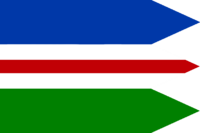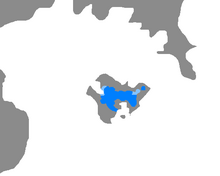Borelian language: Difference between revisions
(Congratulations on having the featured article for September 2021!) |
|||
| Line 1: | Line 1: | ||
{{ | {{Featured_Article}} | ||
{{Region icon Anteria}} | |||
{{Infobox language | {{Infobox language | ||
| name = Borelian<!-- language--> | | name = Borelian<!-- language--> | ||
Revision as of 17:27, 3 September 2021
| Borelian | |
|---|---|
| Borelan, Bolanic | |
| Borεnli - File:BotoBS.png | |
 Ethnic flag of Borelians | |
| Pronunciation | /bɔɾənʟɪ/ |
| Native to |
|
| Region | Storvan island |
| Ethnicity | Storvani aboriginals |
Native speakers | L1: ~530,000 L2: ~230,000 FL: <50,000 |
Bornese
| |
Early forms |
|
Standard forms | Great Borelian Corpus |
| Latin alphabet Boto script | |
| Official status | |
Official language in | |
Recognised minority language in | |
| Language codes | |
| ISO 639-1 | BL |
| ISO 639-2 | BOL |
| ISO 639-3 | BOL |
 Distribution of the language
Absolute majority >30% of native speakers | |
The Borelian language is one of the three Bornese languages, which are language isolate family, spoken by the aboriginals on the island of Storvan, it is recognized as a official language of the Storvan Autonomy and a minority language in Zhousheng.
Alphabet
Alphabetic version:
| A a /a/ |
B b /b/ |
C c /ʃ/ |
D d /d/ |
E e /ɛ/ |
F f /f/ |
G g /g/ |
H h /ɦ/ |
I i /ɪ/ |
Î î /ʝ/ |
| J j /ʒ/ |
K k /k/ |
L l /ʟ ~ l/ |
M m /m/ |
N n /n/ |
O o /ɔ/ |
P p /p/ |
Q q /q ~ kv/ |
R r /ʀ ~ ɾ/ |
S s /s/ |
| T t /t/ |
U u /u/ |
V v /v/ |
Ƿ ƿ /ʋ/ |
X x /χ/ |
Y y /ɨ/ |
Z z /z/ |
& ε /ə/ |
- -Silent- |
Boto version:
| File:BotoBS.png File:BotoBM.png File:BotoBE.png /b/ |
File:BotoPS.png File:BotoPM.png File:BotoPE.png /p/ |
/d/ |
/t/ |
/v/ |
/f/ |
/g/ |
/k ~ χ/ |
/ɦ/ |
/m/ |
/n/ |
/ʀ ~ ɾ/ |
/ʟ ~ l/ |
/s/ |
/z/ |
/ʃ/ |
/ʒ/ |
/a/ |
/ə/ |
/ɛ/ |
/ɪ/ |
/ʝ/ |
/ɔ/ |
/u/ |
-Silent- |
-Space- |
-Period- |
Note: The letter Î/![]() was very often ignored and written as I/
was very often ignored and written as I/![]()
Detailed table
| ||||||||||||||||||||||||||||||||||||||||||||||||||||||||||||||||||||||||||||||||||||||||||||||||||||||||||||||||||||||||||||||||||||||||||||||||||||||||||||||||||||||||||||||||||||||||||||||||||||||||||||||||||||||||||||||||||||||||||||||||||||||||||||||||||||||||||||||||||||||||||||||||||||||||||||||||||||||||||||||||||||||||||||||||||||||||||||||||||||||||||||||||||||||||||||||||||||||||||||||||||||||||||||||||||||||||||||||||||||||||||||||||||||||||||||||||||||||||||||||||||
Controversy about alphabet systems
Ampersand (&)
& ε
Ampersand has been included in the alphabet as the 27th/28th character, with a miniscule ε (simplified from ɛ̗́), which may make the language visually difficult for non-borelians.
Multiple linguists proposed the change in the writing system, replacing Ampersand (&) with the letter Schwa (Ә), which was already implemented in the Storvani language in 1930's. As of now, the proposal is opposed by the majority of the populace as well as the office for literal language. The support for this movement however still rises, as the Ampersand is visually difficult to write correctly when making quick notes.
There was a ironic movement to replace the mniscule ε with ﹠, however, nobody has taken it seriously due to the complexity of the letter.
Ɛ ɛ
The most favored change is, however, writing the &-ε pair as a Ɛ-ɛ. Proponents of this view spearhead following reasons:
- Ɛ-ɛ would simplify the language, as there would be one less character to be learned in school
- Ɛ-ɛ would make the writing easier, because & is hard to write in a fast notetaking
- Ɛ-ɛ would better represent the sound, which is closest sound to E-e pair
Wynn (Ƿ)
Ƿ ƿ
Similar problem exists with the letter for the phoneme /ʋ/, which is not present in Borelian alphabet. While originally, the letter Wynn (Ƿ) was used on all occasions, same as in the Zhoushi language and by proxy by influence from the Storvani language, which in turn took it from Krenyan alphabet,[1] but later, with the rise of the internet, letter "W" became more wide spread because of the adresses starting with "www.". This problem was later solved by auto-redirecting system update, which allowed users to type "ƿƿƿ." and it automatically redirected to "www."
Phonology
| Labial | Coronal | Dorsal | Laryngeal | |||||||||||||||||||||
|---|---|---|---|---|---|---|---|---|---|---|---|---|---|---|---|---|---|---|---|---|---|---|---|---|
| Bilabial | Labiodental | Linguolabial | Dental | Alveolar | Postal-veolar | Retroflex | Palatal | Velar | Uvular | Pharyngeal | Glottal | |||||||||||||
| Nasal | m̥ ( |
m ( |
n̥ ( |
n ( |
||||||||||||||||||||
| Plosive | p (File:BotoPM.png) |
b (File:BotoBM.png) |
t ( |
d ( |
ʈ ( |
ɖ ( |
k ( |
g ( |
q ( |
|||||||||||||||
| Sibilant fricative | s ( |
z ( |
ʃ ( |
ʒ ( |
||||||||||||||||||||
| Non-sibilant fricative | f ( |
v ( |
ʝ ( |
x ( |
ɣ ( |
χ ( |
h ( |
ɦ ( | ||||||||||||||||
| Approximant | ʋ ( |
j ( |
||||||||||||||||||||||
| Tap/Flap | ɾ̥ ( |
ɾ ( |
ʀ̥ ( |
ʀ ( |
||||||||||||||||||||
| Trill | r̥ ( |
r ( |
||||||||||||||||||||||
| Latelar approximant | l ( |
ʟ ( |
||||||||||||||||||||||
| Tongue position | Front | Near-front | Central | Near-back | Back | |||||
|---|---|---|---|---|---|---|---|---|---|---|
| Close | i ( |
ɨ ( |
u ( | |||||||
| Near-close | ɪ ( |
|||||||||
| Close-mid | e ( |
o ( | ||||||||
| Mid | ə ( |
|||||||||
| Open-mid | ɛ ( |
ʌ ( |
ɔ ( | |||||||
| Near-open | ||||||||||
| Open | a ( |
ɑ ( |
||||||||
| Diphthong | u͡ɪ | |||||||||
| Long vowels | aː ~ ɛː ~ ɪː ~ ɔː ~ əː ~ uː | |||||||||
Bold are the common sounds, while regular sounds may happen in dialects and/or in a world for easier pronunciation
Grammar
Predicate-subject complex
While the Borelian language does not have a seperate predicate and subject in sentence, it has one word, which is both a noun phrase and a verb phrase (so called Predicate-subject complex). It is created out of a subjectual prefix, verbal (predicate) root and a optional adjustment suffix.
Subject prefix
Borelian has three grammatical cases for the complex:
The predicate-subject complex can be distinguished from other forms of other complexes, as it uses the predicate term in subjective case.
Predicate root
TBA
Suffixes
Predicate-subject complex has three suffixes, that are added to denote tense, mood and situation respectively. The first suffix (the one closest to the root) denotes tense, the middle suffix denotes mood and the last suffix denotes situation.
Tense suffix
Borelian language has 15 tenses, subdivided into 3 groups:
- Past tenses
- Preterite (Simple past) - Suffix -ba
- Past progressive - Suffix -base
- Pluperfect simple - Suffix -bari
- Pluperfect progressive - Suffix -barε
- Past repetetive - Suffix -bapo
- Present tenses
- Simple present - No suffix
- Present progressive - Suffix -se
- Present perfect - Suffix -ri
- Present perfect progressive - Suffix -rε
- Present repetetive - Suffix -po
- Future tenses
- Simple future - Suffix -fu
- Future progressive - Suffix -fuse
- Future perfect - Suffix -furi
- Future perfect progressive - Suffix -furε
- Future repetetive - Suffix -fupo
Only tenses no present in Common are the repetetives, which denote a action, that happened multiple times in the said time horizon. Such as "Zataribapo" means literally "I used to win (a lot)".
Mood suffix
Borelian language has 5 grammatical moods:
- Indicative - No suffix
- Imperative - Suffix -ti
- Conditional - Suffix -bo
- Questional Indicative - Suffix -xa
- Questional Conditional - Suffix -boxa
Situation suffix
Situational suffix can show multiple adjusting information:
- Negation - Suffix -be
- Doubt - Suffix -pε
- Possibility - Suffix -sa
- Passivity - Suffix -mε
(multiple of those can be used at the same time, there is no rule on the sequence in which those must be used)
Nouns
Nouns in Borelian have 2 genders:
- Masculine - End with a vowel
- Feminine - End with a consonant
- Indifferent - Impossible to distinguish a gender (End with I/Î)
It also has five grammatical cases for nouns:
And seven grades for nouns:
| Grade | Prefix | Meaning | Example | Example translation |
|---|---|---|---|---|
| Negative | Be- | Object lacks the said property | Berutu | No friend of mine |
| Positive | — | Object has the said property | Rutu | A friend of mine |
| Comparative | Meî- | Object A has the said property more than Object B | Meîrutu rutuî | Better friend than that friend |
| Diminutive | Mol- | Object has very little of the said property | Molrutu | Bad/unreliable friend |
| Augmentative | Sti- | Object has a lot of the said property | Stirutu | Good friend |
| Excessive | Rεk- | Object has too much of the said property | Rεkrutu | Person acting excessively friendly |
| Superlative | Sul- | Object has the most of the said property | Sulrutu | The best friend |
Possessive representation
A word can be "owned" by another word in possessive case, if the filler prefix "&dε-" is included. Nouns are not written with a capital character, unlike the complex, so in most cases, you would see a miniscule version "εdε-".
Example of the language
Sonnet 18 translation into Borelian:
| Common | Borelian (Alphabet) | Borelian (Boto) | ||
|---|---|---|---|---|
| Q1 | Shall I compare thee to a summer’s day? | Zakaviboxa dati iz-claxεdime-îuvaci? | ||
| Thou art more lovely and more temperate: | Deba Fildi meîtulraîno- e meîhmarino-: | |||
| Rough winds do shake the darling buds of May, | Xrtiîno-Fucitic &ditεrcε tulratime-budeni εdεdivlini,[a] | |||
| And summer’s lease hath all too short a date: | E claxεdi εdεdendu Zamabapo molklertino-îuvaci: | 4 | ||
| Q2 | Sometime too hot the eye of heaven shines, | Moltliknilo rεkclakino pnimadi εdεkukna &dizermε, | ||
| And often is his gold complexion dimmed; | E stitliknilo Malkedime-canastiîεd &diofzipo; | |||
| And every fair from fair sometime declines, | E Sul-&-zlit moltliknilo &diofzi, | |||
| By chance, or nature’s changing course, untrimmed: | Ti-flivini lim ti-retnaîni εdε-alenino-fnelx, beofzinino: | 8 | ||
| Q3 | But thy eternal summer shall not fade, | Iliî- Dama-sultlikino-claxε &diofzifubobe, | ||
| Nor lose possession of that fair thou ow’st; | Belim Zamat de-cεdi zliti datihεokε &diaxijafubo; | File:BotoBS.png |
||
| Nor shall Death brag thou wander’st in his shade | ||||
| When in eternal lines to time thou grow’st: | 12 | |||
| C | ㅤSo long as men can breathe or eyes can see, | |||
| ㅤSo long lives this, and this gives life to thee. | 14 | |||
| ||||
- ↑ Krenyan language developed as a branch from Gadori germanic language mixture with Common. Dictionary: Common-Krenyan; Krenyan-Common
Alphabet: Aa Ææ Bb Cc Dd Ðð Ee Ff Gg Ȝȝ Hh Ii Jj Kk Ll Mm Nn Ŋŋ Oo Pp Qq Rr Sſs Tt Þþ Uu Vv Ƿƿ Xx Yy Zz